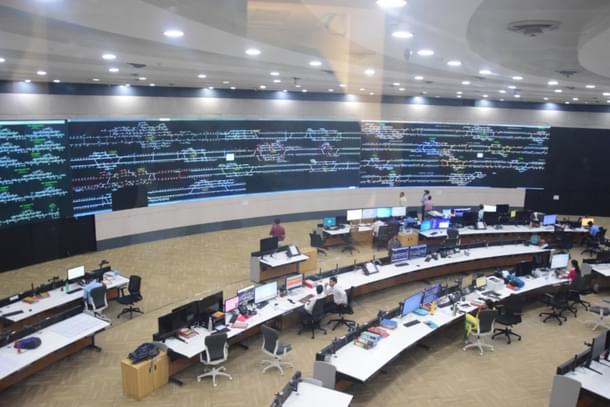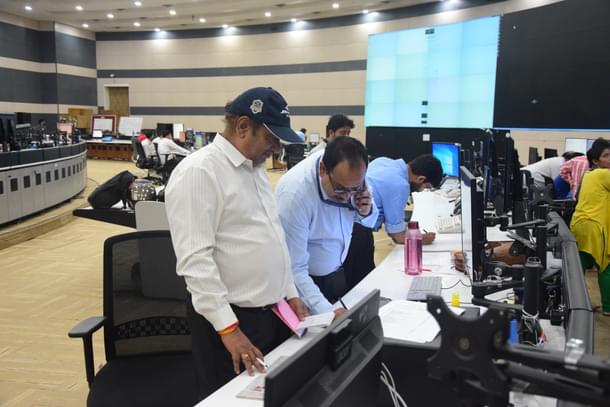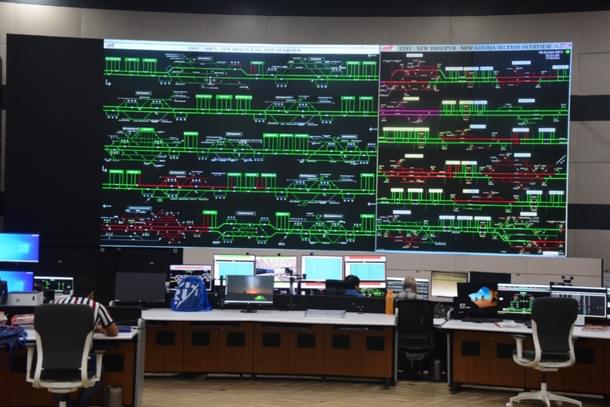Infrastructure
Ground Report: Live Tracking Of Freight Movement On Eastern DFC From Operation Control Centre
Arun Kumar Das
Aug 19, 2023, 03:33 PM | Updated 03:33 PM IST
Save & read from anywhere!
Bookmark stories for easy access on any device or the Swarajya app.


Prayagraj: Looking at a huge live video wall as the 59-wagon freight train entered the Eastern Dedicated Freight Corridor from New Sonnagar station at 1.20am, an excited Chief Controller said "It's through, let it go".
The entry of the freight train loaded with coal from Mahanadi Coal Field and heading towards Talwandi Power Station was the first train of the day (Wednesday, 17 August) which could be spotted live through a yellow colour sign on a 91-metre video wall.
Welcome to the Operation Control Centre at Prayagraj, the first such facility in the Indian rail sector, created for monitoring and ensuring smooth flow of freight movement on Eastern Dedicated Freight Corridor (EDFC) on a real time basis.
The first freight train of the day was followed by 241 goods trains (up and down) on that day including four "pythons".
The two freight trains with 59 wagons each joined together called "python" in rail jargon. Pythons are being used for long and heavy haul as they can carry maximum goods at a time.
The movement of "python" reduces logistic cost as it moves about 10,400 tonne of goods at a time to the destination, explains the Chief Controller at the Operation Centre.
The state-of-the-art 91 metre video wall reflects all actions throughout the day as about 21-odd trained technicians sitting in three rows ensuring smooth run of freight trains on the 1,038 km long Eastern DFC through constant monitoring and instructing the concerned staff on the ground.
The Operation Control Centre witnessed movement of four "Pythons" in the EDFC on 17 August which include 104-wagon freight trains from Ghaziabad to Mirzapur and Sonnagar to Dadri.
"DFC is a rail expressway of the rail network. Our aim is to speed up the goods movement upto 60 to 70 kmph from the current 48 kmph," said the Signal Controller.
With the long video screen on the front wall and all eyes glued on the desk terminals, the Operation Control Centre is buzzing with activities at this early hours.
Amid the hectic activities, all of a sudden there was a big sound bell in the Operation Centre. It was an alert from the Hot Axle Box Detection (HABD) system installed near the track.
An empty rake was coming from New Kundra station and heading towards Gaya. The HABD installed near the track detected anomalies in the bogey and an automatic alert sound generated in the system, said Traffic Rolling Stock (TRS) Controller, responsible for installing and monitoring the system.
The 44th wagon from the locomotive developed the problem and the train was halted near Karandia Station and after rectifying the problem, it would be allowed to go, said the TRS Controller.
Besides, HABD, the EDFC has operationalised Wheel and Bearing Condition System, Machine Vision Inspection System and Wheel Impact Load Detection System.
We follow a predictive maintenance system with all these systems so that problems can be detected and rectified before it develops into a serious flaw and hampered the operation adversely, he said.
There were three alert sounds during the whole day on 17-18 August from different places at different times which were rectified before allowing the trains to move.
Safety is paramount and we have to ensure safety in train operation from here, said one of the Crew Controllers who was on the night shift.
It was 2.30pm and the Operation Control Centre was coming back to action again like a war zone after a brief lull for some time.
"Every day we follow a strict maintenance schedule. We keep four to six hours for maintenance of tracks, OHE, Signal and Telecom and other assets. We re-start the operation after the stipulated time," said the Traffic Controller.
"The operation also takes into account the system of crew change after a certain time," said a Crew Controller who has been at the centre since its inception.
While the mid-shift staff were taking over positions at the Operation Centre, a cattle runover (CRO) incident was reported near Bhaupur which halted the train movement for a brief period.
There were a total of five CRO incidents at different stretches on the EDFC on that day which affected the operation for some time in respective areas.
CRO incidents are regularly happening and we are taking certain precautions to prevent such incidents, said the Traffic Controller.
Besides, there was an OHE (Overhead Equipment) failure because of entanglement of kite thread in the electric system.
The OHE failure was reported at 5.35pm in a section and by 7pm it was rectified and train movement resumed, said the OHE Controller.
Managed by the trained personnel, there is also a viewer gallery where one can see all the action at the Operation Centre.
Traffic Controllers are on the first row, followed by Deputy Chief Controllers at the second row who coordinate with the stations.
Chief Controllers, Tracks Controllers, Signal Controllers and Crew Controllers occupy the third row who take quick decisions in case of emergency.


While the train movement slows down between 11am and 2pm as this time is utilised for track and signal maintenance, the freight service picks up from 2pm and the night time especially after 11pm is considered as peak time as more trains seek a path on the freight corridor.
As of now, EDFC witnesses movement of about 135 trains in a day and after the completion of the entire stretch, the number of trains is expected to increase further.
EDFC operated 302 trains on 13 August, 296 trains on 15 August and 289 trains on 16 August.
We celebrate the day with the distribution of sweets when we have the maximum number of trains on the system, said Chief Traffic Controller.
DFC was created to ensure speedy movement of goods which otherwise took a longer time in the Indian Railways network because of the path congestion. passenger-carrying trains always get preference over the goods trains as a result freight movement always slows down.
"Speed plays a crucial role in delivering goods in the DFC," said Chief Traffic Controller.
Pointing out towards a particular white stretch on the screen, he said "A freight train carrying coal entered at Pathardih station in the EDFC on 16 August at 11.20am and exited at New Bokari station at 8.25pm covering 900 km in 21 hours in an average speed of 42 kmph which would have taken about four days in the Indian Railways system".
Similarly an empty freight train heading towards Dhanbad for coal loading entered the New Bokaki staion on 16 August at 5.45 AM and and exited at New Sonnagar on 17 August at 1.51am covering 900 km in 18 hours 19 minutes in average speed of 49 kmph.
There were 14 freight trains which reached their destinations in record time and were included in the category of best performances on 17 August.
The personnel mostly technocrats deployed at the Rs 200 crore Operation Centre Complex at Prayagraj are being trained at Heavy haul Institute.





